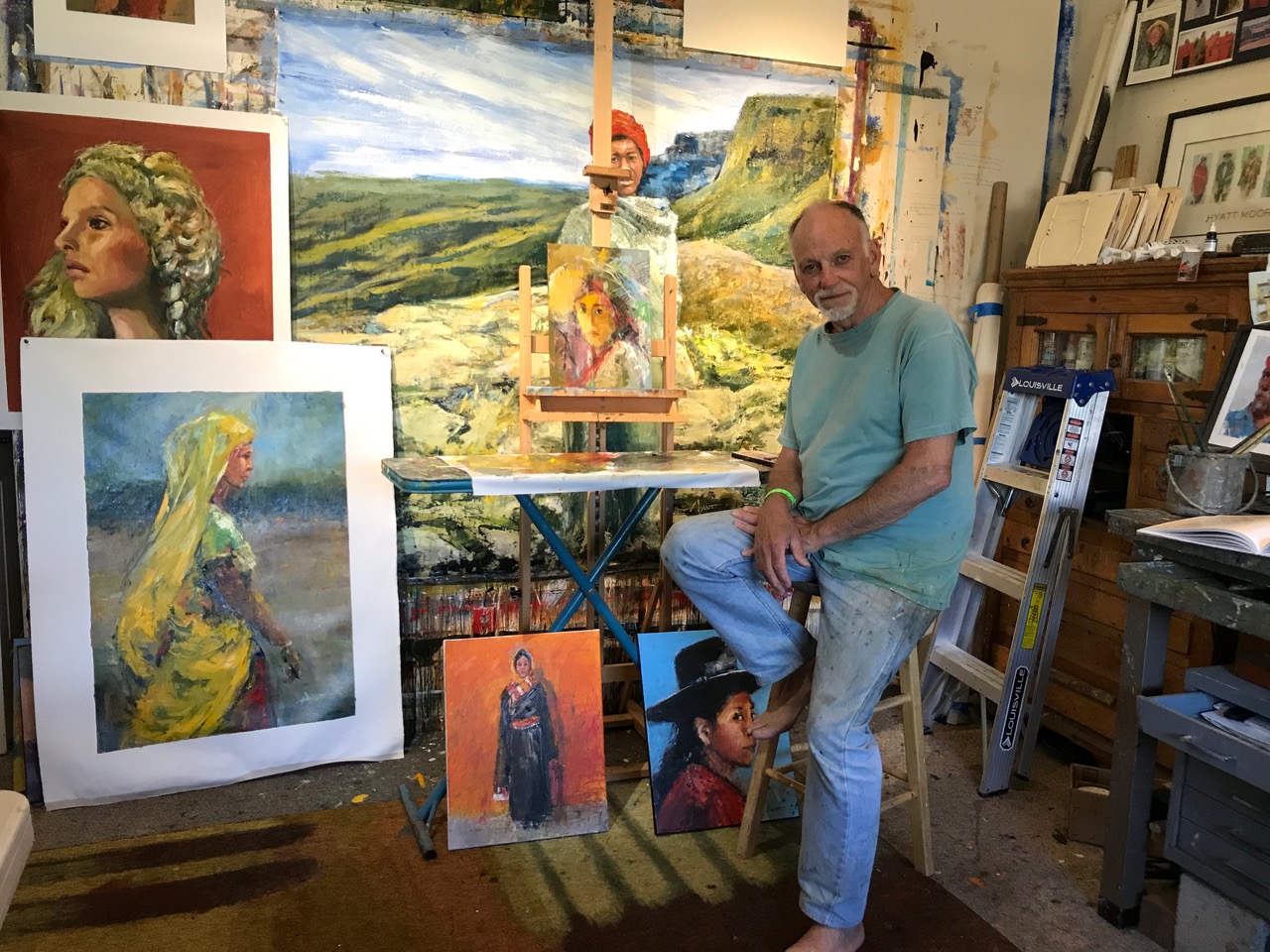How can we explain the bewildering moments in our story where nothing dramatic happens but, by some flicker of light or pivot within, we find ourselves changed? We listen faithfully for whispers, some of which becoming callings we could never have anticipated. If we are willing to extend our palms in those moments, we may catch the curveball like a golden egg.
“Over twenty years ago, Hyatt Moore, was not the world-renowned painter that we know today.”
Over twenty years ago, Hyatt Moore, was not the world-renowned painter that we know today. In fact, twenty years ago Moore was not a painter at all. He could not have imagined that his paintings would be commissioned all around the world, leading him eventually to a full time career as a painter. Why would he? He was the President of Wycliffe Bible Translators. With a colorful assortment of occupations within the organization before his presidency, Moore had an established career as an art director and graphic designer even before that.
But in 1996, Moore was driving home within his native state of California when he found himself paused at a traffic light by Laguna Beach. As was his custom, Moore cast a cursory glance into one of the many galleries scattered around that area. It was then he saw the painting.
““But all in a moment, I knew I was going to be a painter. I was so jazzed by it, so excited.””
“Perhaps it was a landscape,” Moore imagines, the actual image unclear. “But all in a moment, I knew I was going to be a painter. I was so jazzed by it, so excited.” Years later, time has done little to dull the delight thrumming through Moore’s voice as he recounted that moment. “It didn’t make any sense but that was just the beginning.”
Flash forward to 2013, several hundred miles east in early spring. In the suburb of Barrington, IL and Christine Gunn-Danforth, CEO and founder of the Jonahre Foundation, was in the blur of a vision she had also received: to launch the first Art Walk in 30 days. But as she commissioned each artist for a twelve piece series depicting the events of Easter through the motif of hands, it was only two weeks out that Christine approached Moore with a daring request.
Danforth had become fast friends with Moore at a conference they had both attended in South Africa, their love for art and theology forging a unique bond. Although she admired him as an artist, it was only until Danforth had a distinct vision of Jesus offering His hands to Thomas for the final piece that she knew Moore was the only person to ask for this painting-a “Sistine Chapel-like painting,” in its proportions.
Moore, who accepts the few biblical art commissions that he does prayerfully, is known for his large canvas, impressionistic renderings of indigenous people from around the world among many other works. Yet despite the size and swiftness of the request, Moore felt compelled to accept.
Image of Moore’s home in California courtesy of hyattmoore.com
Shortly after accepting Danforth’s request, Moore stepped outside his home in California and stumbled upon two of his good friends nearby. “That doesn’t happen often,” he said, “so I had us take the picture right there.” The picture that would be the reference for ‘Hands of Doubt’ was modeled with his friend’s hands as Jesus, and Moore’s own as Thomas.
“Hands of Proof,” Moore corrected. Pausing in our conversation, I realized I had mistakenly referred to his painting as, “Hands of Doubt.” It was a slip that surprised neither of us. After all, the scene that the expansive 7ft x 8ft painting references is between a resurrected Christ and the disciple we know as, “Doubting Thomas.”
“Thomas: he gets a bad rep,” Moore empathized. “Jesus had non-believers ask him all the time to perform miracles, and he never would.” But when it came to the crossroads of faith, Thomas who was clearly a disciple of Jesus, was asked to do something that not asked of the other disciples: to believe without proof.
“He probably wanted to believe, but it was too hard for him because he had seen it all happen.” The arrest, the mockery of trial, the brutality of crucifixion and burial of his teacher and friend's lifeless corpse. It would be a tall ask of anybody. “An honest doubter,” Moore called Thomas, suspecting that was the reason why Jesus provided Himself as the proof he so desperately needed.
In our own lives, how often do we long for those same nail-pierced hands to extend themselves before us? How often do we wish we could believe in the glory of Easter in a way that could redeem the chaos and dysfunction of our own stories? Or in Pentecost Sunday? Fifty days after Passover and Easter, we are told Jesus’ promise to send the Holy Spirit as an ever-present helper came with fire and wind, and a momentum that propelled 3000 people to faith in one day.
It is the kind of longing rooted in the tension between all the ways we want to believe and all the ways it seems impossible to. But every once in a while, if we are perhaps willing to be silenced and spoken to-in a store by a painting, at a traffic light on our way to our busy lives with established careers-we may get a glimpse of the proof we so desire. A moment of complete awe.
“Thomas said to him, ‘My Lord and my God!’ Then Jesus told him, ‘Because you have seen me, you have believed; blessed are those who have not seen and yet have believed.’”
John 20:28-29
Read more about the making of “Hands of Proof” and other works by Hyatt Moore here.



